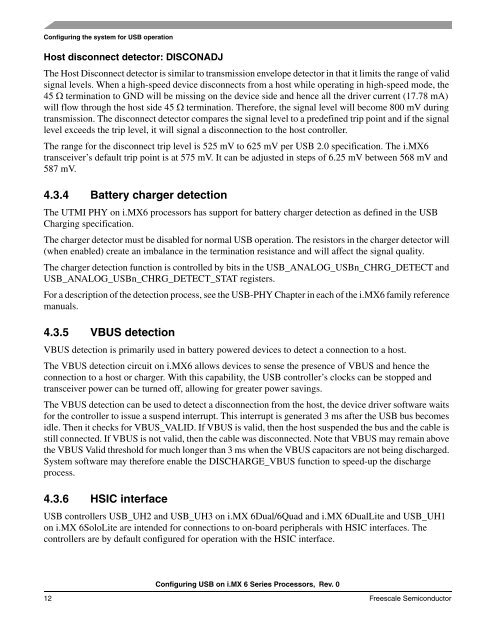Configuring USB on i.MX 6 Series Processors - Freescale ...
Configuring USB on i.MX 6 Series Processors - Freescale ...
Configuring USB on i.MX 6 Series Processors - Freescale ...
You also want an ePaper? Increase the reach of your titles
YUMPU automatically turns print PDFs into web optimized ePapers that Google loves.
<str<strong>on</strong>g>C<strong>on</strong>figuring</str<strong>on</strong>g> the system for <str<strong>on</strong>g>USB</str<strong>on</strong>g> operati<strong>on</strong><br />
Host disc<strong>on</strong>nect detector: DISCONADJ<br />
The Host Disc<strong>on</strong>nect detector is similar to transmissi<strong>on</strong> envelope detector in that it limits the range of valid<br />
signal levels. When a high-speed device disc<strong>on</strong>nects from a host while operating in high-speed mode, the<br />
45 Ω terminati<strong>on</strong> to GND will be missing <strong>on</strong> the device side and hence all the driver current (17.78 mA)<br />
will flow through the host side 45 Ω terminati<strong>on</strong>. Therefore, the signal level will become 800 mV during<br />
transmissi<strong>on</strong>. The disc<strong>on</strong>nect detector compares the signal level to a predefined trip point and if the signal<br />
level exceeds the trip level, it will signal a disc<strong>on</strong>necti<strong>on</strong> to the host c<strong>on</strong>troller.<br />
The range for the disc<strong>on</strong>nect trip level is 525 mV to 625 mV per <str<strong>on</strong>g>USB</str<strong>on</strong>g> 2.0 specificati<strong>on</strong>. The i.<strong>MX</strong>6<br />
transceiver’s default trip point is at 575 mV. It can be adjusted in steps of 6.25 mV between 568 mV and<br />
587 mV.<br />
4.3.4 Battery charger detecti<strong>on</strong><br />
The UTMI PHY <strong>on</strong> i.<strong>MX</strong>6 processors has support for battery charger detecti<strong>on</strong> as defined in the <str<strong>on</strong>g>USB</str<strong>on</strong>g><br />
Charging specificati<strong>on</strong>.<br />
The charger detector must be disabled for normal <str<strong>on</strong>g>USB</str<strong>on</strong>g> operati<strong>on</strong>. The resistors in the charger detector will<br />
(when enabled) create an imbalance in the terminati<strong>on</strong> resistance and will affect the signal quality.<br />
The charger detecti<strong>on</strong> functi<strong>on</strong> is c<strong>on</strong>trolled by bits in the <str<strong>on</strong>g>USB</str<strong>on</strong>g>_ANALOG_<str<strong>on</strong>g>USB</str<strong>on</strong>g>n_CHRG_DETECT and<br />
<str<strong>on</strong>g>USB</str<strong>on</strong>g>_ANALOG_<str<strong>on</strong>g>USB</str<strong>on</strong>g>n_CHRG_DETECT_STAT registers.<br />
For a descripti<strong>on</strong> of the detecti<strong>on</strong> process, see the <str<strong>on</strong>g>USB</str<strong>on</strong>g>-PHY Chapter in each of the i.<strong>MX</strong>6 family reference<br />
manuals.<br />
4.3.5 VBUS detecti<strong>on</strong><br />
VBUS detecti<strong>on</strong> is primarily used in battery powered devices to detect a c<strong>on</strong>necti<strong>on</strong> to a host.<br />
The VBUS detecti<strong>on</strong> circuit <strong>on</strong> i.<strong>MX</strong>6 allows devices to sense the presence of VBUS and hence the<br />
c<strong>on</strong>necti<strong>on</strong> to a host or charger. With this capability, the <str<strong>on</strong>g>USB</str<strong>on</strong>g> c<strong>on</strong>troller’s clocks can be stopped and<br />
transceiver power can be turned off, allowing for greater power savings.<br />
The VBUS detecti<strong>on</strong> can be used to detect a disc<strong>on</strong>necti<strong>on</strong> from the host, the device driver software waits<br />
for the c<strong>on</strong>troller to issue a suspend interrupt. This interrupt is generated 3 ms after the <str<strong>on</strong>g>USB</str<strong>on</strong>g> bus becomes<br />
idle. Then it checks for VBUS_VALID. If VBUS is valid, then the host suspended the bus and the cable is<br />
still c<strong>on</strong>nected. If VBUS is not valid, then the cable was disc<strong>on</strong>nected. Note that VBUS may remain above<br />
the VBUS Valid threshold for much l<strong>on</strong>ger than 3 ms when the VBUS capacitors are not being discharged.<br />
System software may therefore enable the DISCHARGE_VBUS functi<strong>on</strong> to speed-up the discharge<br />
process.<br />
4.3.6 HSIC interface<br />
<str<strong>on</strong>g>USB</str<strong>on</strong>g> c<strong>on</strong>trollers <str<strong>on</strong>g>USB</str<strong>on</strong>g>_UH2 and <str<strong>on</strong>g>USB</str<strong>on</strong>g>_UH3 <strong>on</strong> i.<strong>MX</strong> 6Dual/6Quad and i.<strong>MX</strong> 6DualLite and <str<strong>on</strong>g>USB</str<strong>on</strong>g>_UH1<br />
<strong>on</strong> i.<strong>MX</strong> 6SoloLite are intended for c<strong>on</strong>necti<strong>on</strong>s to <strong>on</strong>-board peripherals with HSIC interfaces. The<br />
c<strong>on</strong>trollers are by default c<strong>on</strong>figured for operati<strong>on</strong> with the HSIC interface.<br />
<str<strong>on</strong>g>C<strong>on</strong>figuring</str<strong>on</strong>g> <str<strong>on</strong>g>USB</str<strong>on</strong>g> <strong>on</strong> i.<strong>MX</strong> 6 <strong>Series</strong> <strong>Processors</strong>, Rev. 0<br />
12 <strong>Freescale</strong> Semic<strong>on</strong>ductor













